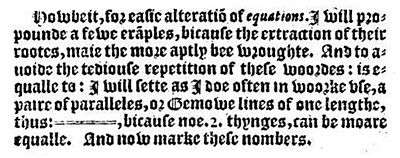The Whetstone of Witte

The Whetstone of Witte is the shortened title of Robert Recorde's mathematics book published in 1557, the full title being The whetstone of witte, whiche is the seconde parte of Arithmetike: containyng thextraction of Rootes: The Coßike practise, with the rule of Equation: and the woorkes of Surde Nombers. The book covers topics including whole numbers, the extraction of roots and irrational numbers.[2] The work is notable for containing the first recorded use of the equals sign[3] and also for being the first book in English to use the plus and minus signs.[4]
Recordian notation for exponentiation, however, differed from the later Cartesian notation . Recorde expressed indices and surds larger than 3 in a systematic form based on the prime factorization of the exponent: a factor of two he termed a zenzic, and a factor of three, a cubic. Recorde termed the larger prime numbers appearing in this factorization sursolids, distinguishing between them by use of ordinal numbers: that is, he defined 5 as the first sursolid and 7 as the second sursolid.[5] He also devised symbols for these factors: a zenzic was denoted by z, and a cubic by &. For instance, he referred to p8=p2×2×2 as pzzz (the zenzizenzizenzic of p), and q12=q2×2×3 as qzz& (the zenzizenzicubic of q).[6]
References
- ↑ Robert Recorde (1557). The whetstone of witte, whiche is the seconde parte of Arithmetike: containyng thextraction of Rootes: The Coßike practise, with the rule of Equation: and the woorkes of Surde Nombers (PDF). London: Jhon Kyngstone.. Page 238 in the pdf file.
- ↑ Williams, Jack (2011), "The Whetstone of Witte", Robert Recorde: Tudor Polymath, Expositor and Practitioner of Computation, History of Computing, Springer, pp. 173–196, doi:10.1007/978-0-85729-862-1_10, ISBN 9780857298621.
- ↑ Atkins, Peter (2004), Galileo's Finger:The Ten Great Ideas of Science, Oxford University Press, p. 484, ISBN 9780191622502.
- ↑ Cajori, Florian (2007), A History of Mathematical Notations, Cosimo, p. 164, ISBN 9781602066847.
- ↑ Williams (2011), p. 180.
- ↑ Williams (2011), p. 184.